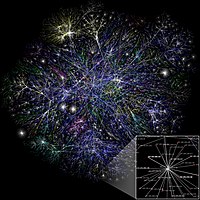
Photo from wikipedia
The Bitcoin Lightning Network (LN) disrupts the scenario as a fast and scalable method to make payment transactions off-chain, alongside the Bitcoin network, thereby reducing the on-chain burden. Understanding the… Click to show full abstract
The Bitcoin Lightning Network (LN) disrupts the scenario as a fast and scalable method to make payment transactions off-chain, alongside the Bitcoin network, thereby reducing the on-chain burden. Understanding the topology of the LN is crucial, not only because it is key to performance, but also for ensuring its security and privacy guarantees. The topology of the LN affects, among others, the ability to successfully route payments between nodes, its resilience (against both attacks and random failures), and the privacy of payments. Existing research on LN topology focuses on studying the degree, betweenness, and closeness as metrics that better describe the centrality of nodes. However, to the best of our knowledge, previous studies do not encompass the network as a whole because of the limitation of using only the capacity of channels as its principal property. The contributions of this study are two-fold. On the one hand, this paper discusses the application of classic centrality metrics for evaluating the centrality in the LN. On the other hand, we provide alternative metrics to evaluate centrality. Our approach extends the analysis by adding metrics (strength, Opsahl, current-flow betweenness) and network properties (capacity, fee, balance, channel, and pending Hashed Timelock Contracts (HTLCs)). Based on the results obtained using these metrics, we provide an in-depth analysis of the metric that best defines the centrality of this network.
Journal Title: IEEE Access
Year Published: 2022
Link to full text (if available)
Share on Social Media: Sign Up to like & get
recommendations!